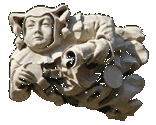
Wicelinus Dux
c. 1354 - 1383 ?
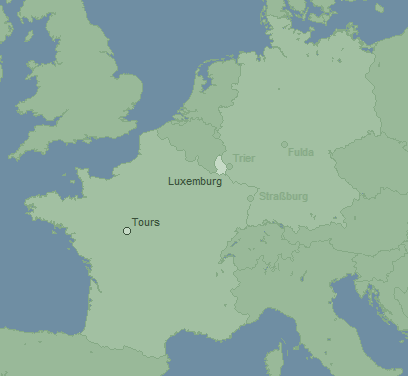
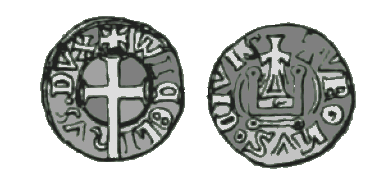
obs. +VVICELI=RVS � DVX; rev. TVRONVS � CIVIS.

n interesting occurance of the name Wicelinus appears on a coin from the Middle Ages. A few coin experts suggest that it was minted between 1354 and 1383. An inscription of Wicelinus Dux appears on the front side of the coin. On the back of the coin is a simplistic representation of the Tournois Castle, a design originating from the mint at the abbey of St Martin of Tours in France which continued in use from the 11th to the early 14th century. These coins of Tours are commonly refered to as deniers tournois. So influencial were the coins from this mint that the style was imitated widely, appearing even on crusader coins as far south as the mint in Thebes.
The Wicelinus Dux coin has been tenatively associated with Wenceslas (Wenzel) I, King of Bohemia, but also Duch� of Luxenbourg by marriage between 1353 and 1383.
Diese geringhaltige M�nze lag seit langen Jahren in meiner Sammlung im Anhange zu meinen franz�sischen Mittelalterm�nzen. Sie hatte dort ihren Platz, weil wenigstens das Zeichen von Tours auf ihr sichtbar war. Im Uebrigen liess der starke, anscheinend nicht zu l�sende Rost�berzug nichts erkennen. Nach einer neulich vorsichtig vorgenommenen Reinigung jedoch war es m�glich, ein getreues Bild von dem St�cke, wie vorstehend wiedergegeben, zu erhalten. Damit erwies sich die M�nze als, meines Wissens, noch nicht bekannt gemacht. This coin of little importance has for long years been a unimportant addition to my collection of my Medieval French coins. It had its place there, because at least the sign of Tours was visible on it. Given the strong rusty cover which seemed impossible to remove, it revealed noting else. After a careful cleaning done recently, it was possible though to obtain a true picture of the piece, as rendered above. The coin proved not to be commonly known, according to my knowledge. Auf den ersten Blick stellt sie sich als Nachahmung eines franz�sischen Urtypus dar. Es ist allbekannt, dass mittelalterliche M�nzen, die im allgemeinen Verkehre beliebt waren, Nachahmung nicht nur in den Nachbarfindern fanden, sondern auch weit in die Fremde ihr Bild hinaustrugen und verbreiteten. Es er�brigt sich, lange Reihen solcher Nachahmungen aller Orten hier aufzuf�hren, es sei nur auf zwei franz�sische M�nzsorten hingewiesen, die der Nachahmung besonders verfallen sind. At first glance, it presents itself as an imitation of a French archetype. It is fairly well known that medieval coins, that were popular in general usage, found imitation not only in neighboring regions, but also far abroad. Their style found influence and spread. It is not necessary to list the long series of such imitations in all places, we only want to point out two French coin-types that were most often imitated. Das ist in erster Linie der gros tournois. Zuerst in Tours im 13. Jahrhundert aufgekommen, war er nicht allein in Frankreich f�r lange Zeit gebr�uchlich, sondern auch in den Niederlanden, den Rheingegenden, 'Westfalen und noch weiter verbreitete sich sein Typus. Besonders die kleinen F�rsten und Herren bedienten sich desselben mit Vorliebe, um in gewinnbringender Absicht ihrem eigenen Gelde eine leichtere Annahme zu sichern. Primary is the gros tournois. It is first seen in Tours in the 13th century. It was not only used for a long time in France, but this type of coin also spread to the Netherlands, to the Rhine areas, Westphalia and even further. Especially, minor princes and noblemen preferred to use this type in order to secure easy acceptance for their own currency with the intent of gaining profit.
An zweiter Stelle ist der denier tournois zu nennen, der schon unter Philipp II. (1180-1223) entstanden war und vielfach nachgepr�gt wurde, selbst von den Kreuzfahrern in Griechenland ; doch hat seine Verbreitung nicht den Umfang angenommen wie die des gros tournois. Secondly, the denier tournois should be mentioned that was coined under Philipp II. (1180-1223) and often coined by imitators, even by the crusaders in Greece. But its usage did not spread as widely as the gros tournois.
Zu dieser zweiten Sorte geh�rt auch die hier vorliegende M�nze, wie ihr Aeusseres zeigt. Von welchem Lande sie ausgegangen ist, l�sst sich nicht sogleich sagen. Die R. f�hrt den Stadtnamen der Urst�cke unver�ndert TVROMVS CIVIS, doch kann deshalb die M�nze nicht etwa in Tours gepr�gt sein, dazu passt wiederum der Name des M�nzherrn auf der Hs. VVIQ6LIItVS nicht. Aber auch die Umschau nach einem Herrn dieses Namens f�hrt zun�chst zu keinem Resultat. Denn der einzige Wicelinus, der Bischof von Strassburg (1001-1029), ist nat�rlich seiner fr�hen Zeit halber und wegen des Titels dux auf der M�nze ausgeschlossen. The present coin belongs to this second type, as its appearance shows. It can not be said with certainty what country it is from. The reverse uses, without change, the city name of the original archetype, TVROMVS CIVIS, but the coin could not have been coined in Tours; because the name of the coin�s lord on the obverse, VVICELINVS, is out of place. The search for a leader by that name does not yield a result. Because the only Wicelinus, the bishop of Strassburg (1001-1029), must be excluded because of his earlier time and because of the title dux on the coin. Wenn ich da nun den b�mischen K�nig Wenzel I., der von 1354 bis zu seinem Tode 1383 auch Herzog von Luxemburg war, heranziehe, so glaube ich damit den richtigen Ort f�r unsere M�nze gefunden zu haben. But by associating the Bohemian King Wenzel I, who was also the duke (Herzog) of Luxemburg from 1354 to his death in 1383, I believe to have found the right place for our coin. Die Luxemburger Herzoge bedienten sich vielfach franz�sischer Typen. Wenzel I. machte davon keine Ausnahme : das vortreffliche Buch des f�r die M�nzwissenschaft leider zu fr�h verstorbenen Raymond Serrure, Essai de nunzismatique luxenabourgeoise belegt dies zur Gen�ge. Unter seinen M�nzen befindet sich auch ein Exemplar nach Art des denier tournois (No 16), f�r Luxemburg gesichert durch die Angabe der M�nzst�tte mit TVRONVS LVCEB urgensis , w�hrend unser St�ck TVRONVS CIVIS liest. Auch das Kreuz der Hs. dieser beiden, �brigens in der Gr�sse sehr verschiedenen, differirt betr�chtlich von einander; dasjenige mit dem langen Fusse auf letzterem d�rfte den Bourgeois entlehnt sein. Dem Serrureschen reihe ich dies neue St�ck an. Die Stelle wird ihm durch die Namensform der Hs. nicht streitig gemacht. Denn wenn man auf luxemburgischen M�nzen statt Wenzeslaus die Formen Winzel, Wicel und gar Wicelardus angewendet sieht, dann muss auch vor dem Wicelinus unserer M�nze jeder Zweifel verstummen. The dukes of Luxemburg often used French coin types. Wenzel I. was no exception: the excellent book by Raymond Serrure who unfortunately passed away too early for the science of coins, Essai de nunzismatique luxenabourgeoise , proves this sufficiently. Among his coins, there also is one denier tournois (No 16), proven as coming from Luxemburg by the fact that the coinage place TVRONVS LVCEB(urgensis) is given, while our coin reads TVRONVS CIVIS. Also the cross of the obverse of the two of them, differing very much in their size, differs considerably. One has a longer foot than the other and must have been borrowed from the Bourgeois. To the Serrure example, I add this new one. It will not be possible to dispute this placing because of the form of the name on the obverse. If one sees the forms Winzel, Wicel and Wicelardus on Luxemburg coins instead of Wenzellaus, then all doubt with regard to the Wicelinus of our coin will some certainty. Auf die Pr�gest�tte dieses denier tournois weist nichts hin. Man hat also die Wahl zwischen Luxemburg, Musson und Yvoix; die letzteren beiden sind indessen von untergeordneter Bedeutung gewesen. There is nothing that points to the place where this denier tournois was made. So you have the choice between Luxemburg, Musson, and Yvoix, the latter two were of lesser significance. Dass ich endlich nicht Wenzel II. mit diesem St�cke bedenke, hat seinen Grund in typischen Erw�gungen und in dem Umstande, dass dieser Herr auf seinen luxemburgischen M�nzen sich stets des Titels rex bediente, w�hrend diesem denier tournois der Titel dux eigen ist. That I do not connect Wenzel II with this coin is based on typical considerations and the fact that this ruler always used the title king for his Luxemburg coins while this denier tournois owns the title dux (duke). (Bahrfeldt, 'Wicelinus Dux') |
The Wicelinus Dux coin received some attention among coin experts, but additional details are not to be found.
Le Dr Emil Bahrfeldt apporte dans son article intitul�: Wicelinus dux (p. 346 � 348), un nouveau t�moin de la diffusion de la monnaie tournois. C'est un denier aux l�gendes: Turonus civis et Wicelinus dux. Ce duc doit probablement �tre identifi� avec Venceslas, fils de Jean, comte de Luxembourg, en faveur de qui l'empereur Charles IV �rigea en 1354 le comt� de Luxembourg en duch�, et qui mourut en 1383. The doctor Emil Bahrfeldt brings in his article entitled �Wicelinus Dux� (p. 346-348) a new witness for the spreading of the money of Tours. It is a denier with the legends Turonus Civis and Wicelinus Dux. This duke should probably be identified as Venceslas, son of Jean, Count of Luxemburg, in whose favor, the emperor, Charles IV, created in 1354 the Duch� of Luxemburg, and who died in 1383. (Prou, Le Moyen �ge) |
What can be learned is that the design of the deniers tournois was quite common. And the use of such coins was wide spread.
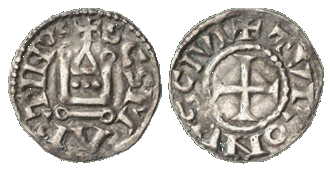
Anonymous deniers tournois of the 13th Century, St. Martin de Tours.
Among the crusaders the coins were common, even struck in metals other than silver. The design shows no change except for the various inscriptions denoting the leader who issued the coin and the mint in which it originated.
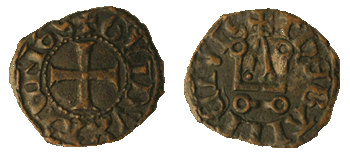
Guy II de la Roche (1287-1308). obs. GVI DVX ATENES; rev. THEBANI CIVIS (Thebes).
The larger gros tournois shows the same design as its center. And on these coins can be found the titles of Rex (king), Comes (count) and Dux (duke).
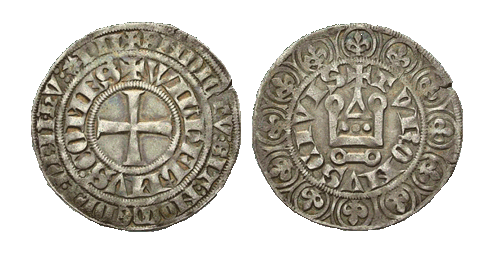
WILHELM II, Graf 1360-1380 obs. +WILHELMVS.COMES; rev. TVRONVS CIVIS
But little can be found regarding the inscriptions used by Wenceslas I of Luxenbourg. His coins often do not indicate his name. And the inscription of Wicelinus is not found in other examples.
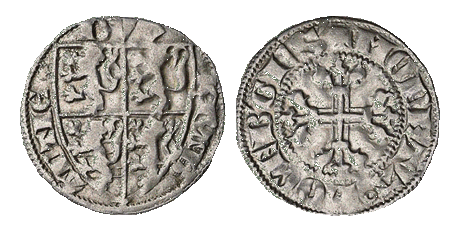
Wenceslas I, Duch� of Luxenbourg 1353-1383 obs. ??; rev. + MONET?[..] LOCEBGES
Assigning the name Wicelinus as a form of Wenceslas leaves a great deal of uncertainty. Elsewhere, Wicelin in associated with the name Werner, and Witzel with the name Wigand. The personal name Witzel does seem to evolve from earlier forms such as Wicelin and the Latin form Wicelinus. George Witzel is referred to as Wicel in letters of correspondence. What is learned from these examples is that varous historians draw various conclusions for various reasons. And the fact that all these names begin with 'W' seems the most common characteristic. But if Wicelinus relates in anyway with the Middle High German word wisel meaning dux or leader, then it might be possible to see these associations perhaps drawing upon the the title of the individuals involved as much as the likelihood that Wicelin was a short form of any of one or even all of these names. Unfortunately, the study of this coin offers no greater clarity, but instead adds to the potential questions a continued research must ask.
� |
Translations of the above texts were prepared with the kind assistance of Klaus Tappe. |
5 - 18 - 2007
� |
Bahrfeldt, Emil. 'Wicelinus Dux'. Congr�s international de numismatique de 1900. Paris: Societe Francaise de Numismatique, 1900. pp. 346-348. Retrived on May 18, 2007: http://books.google.com/books?id=gT6i-EtCWtoC&pg=RA1-PA448&dq=wicelinus+dux#PPA346,M1 � |
� |
Prou, Maurice. Le Moyen �ge: Revue D�Histoire & De Philologie, 2nd Series, Vol. VI, Paris: Librairie Emile Bouillon, Editeur, 1902, pp. 271-272. Retrived on May 18, 2007: http://books.google.com/books?id=omcFAAAAIAAJ&pg=PA271&dq=wicelinus+dux � |
� |
'Coins of the Kings of France'. Retrived on May 19, 2007: http://home.eckerd.edu/~oberhot/froy.htm � |

� Home � Site Menu � Contact �

